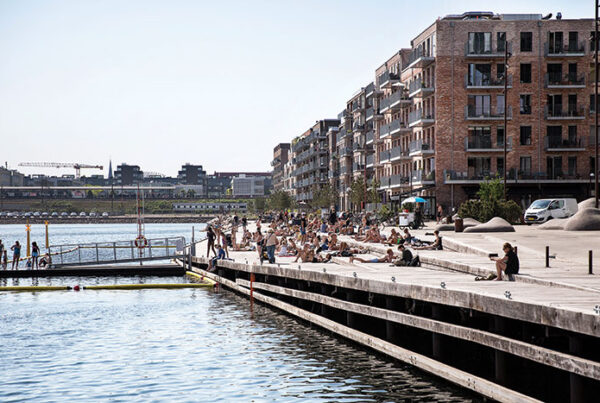A new ULI report finds that now is the time for the real estate industry to make the business case for electrifying more commercial assets and how that can contribute to much-needed climate change mitigation.
Electrify: The Movement to All-Electric Real Estate documents how the commercial real estate industry can shift toward a decarbonized future by moving to all-electric buildings, and the importance of why real estate firms need to be aware of the movement. Although widespread adoption of all-electric assets is not anticipated for at least five to 10 years, the movement toward electrification and away from fossil fuel combustion in buildings is well underway.
Many real estate owners and developers have already begun factoring the coming building electrification boom into their bottom line and strategizing about how it may affect their properties. Along with the financial benefits, electrification is also a key strategy for decarbonizing the building sector and offers notable health and safety benefits.

30 Van Ness Street (center) in San Francisco will be Lendlease’s first all-electric development in the United States.
“How a commercial real estate asset is powered, whether by fossil fuels or electricity, is no longer a niche question only sustainability experts are considering,” says Emily Pierce, author of Electrify and director for ULI’s Greenprint Center for Building Performance. “This report highlights not only what an ‘electric asset’ is and the technology that goes into one, but also provides examples of how to get there with strategies real estate firms can employ now. Cities across the U.S. are increasingly setting carbon emissions reduction goals and passing fossil fuel bans, and more tenants demand sustainable spaces. Electrify breaks down a complex topic into manageable summaries to help guide real estate firms through this evolving opportunity.”
Although nuances exist depending on construction type (new or retrofit), asset classification, climate zone, and utility fuel source availability (i.e., natural gas, coal, electricity, or renewable energy), many of the benefits can be applied widely across commercial real estate:
- Financial benefits: An all-electric building can provide significant cost savings both during development and operations. According to the Building Decarbonization Coalition, gas distribution system expenditures continue to increase, tripling between 2009 and 2017 to $14.9 billion per year, which, in turn, affects the costs of construction. Beyond the direct cost savings of avoided gas line installations, developers are finding that when planning to go all-electric from the start in new developments, net upfront costs are minor and the project forgoes the future cost risks of an all-electric retrofit.
- Impending Regulation: The United States, and countries around the world, have seen a rapid increase in local regulations restricting or banning natural gas lines from new construction, and more cities are working on other electrification strategies. Even if a city does not have a gas ban in place, responding to these potential policies and getting ahead of them can prove to be a useful strategy for long-term planning.
- Technical benefits: While all-electric buildings are not a new concept, advances in electric technologies like heat pumps are enabling buildings to gain value from the overall increased energy efficiency of building systems and from optimized interconnectivity with the utility grid.
- Environmental benefits: All-electric equipment contributes to the overall environmental performance of an asset, both for carbon emissions reductions and for the health and safety of the space and its occupants. The burning of fossil fuels on site, such as on a gas cooktop or boiler, is inherently bad for indoor air quality and can harm occupants when exposed over the long term, such as those working in commercial kitchens. Furthermore, a building cannot meet the strictest definition of net zero until it is all electric and powered by renewable energy. With more and more government, corporate real estate, and end-user goals setting net-zero goals, forward-thinking real estate owners and investors are including electrification in broader environmental, social, and governance (ESG) business plans.

The Tyler, a 55+ senior-living community in East Haven, Connecticut, is the first adaptive reuse project in the United States designed to adhere to the Passive House Institute’s EnerPHit program standards with applicable historic exclusions. (Winn Companies)
Some real estate companies already have either retrofitted older buildings to become all-electric or decided on all-electric new developments from the start:
- 30 Van Ness, San Francisco: Lendlease’s 30 Van Ness is the firm’s first all-electric mixed-use development in the United States. But the decision to go all-electric was made long before San Francisco passed a “no gas” policy. Lendlease’s motivation behind the net-zero-ready project, slated for completion by 2024, is threefold: alignment to prospective tenant aspirations for next-generation office space, environmental considerations and corporate ESG goals, and the desire to be an innovative leader in the space. Lendlease also created a detailed marketing and education plan to highlight the all-electric benefits for residents and tenants.
- The Tyler, East Haven, Connecticut: Multifamily developer WinnCompanies converted an adaptive reuse of a high school that had been vacant for 30 years, creating 70 new all-electric mixed-income housing units for seniors aged 55 years and up. The 104,000-square-foot Passive House retrofit project includes high-efficiency upgrades and a 90-kw solar array, and reuses the building’s existing materials to avoid 18,000 metric tons of greenhouse gas emissions (as measured by the project’s embodied energy value).
Learn more about Electrify: The Movement to All-Electric Real Estate, and register for an upcoming ULI webinar on the topic.




